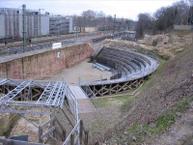The Romans frequently described the Rhine as an important natural border between Gaul on the west, which became part of the Roman empire, and the Germanic territories to the east. The Germani on the east side of the Rhine were considered to be living in their original homeland. So this land was referred to not only as "Germania Transrhenana," (the opposite of cisrhenana) but also, for example by Ptolemy and Strabo, as Germania magna, meaning "Greater Germany. In contrast, the cisrhenane Germani were sometimes referred to as living in Germania cisrhenana, but this territory was considered to also be part of Gaul, and later part of the Roman empire.
In 83 AD Germania Superior and Germania Inferior were separated from Belgica. Their Capitals were Mogontiacum (Mainz) and Colonia Agrippinensis (Cologne) respectively.
In 83 AD Germania Superior and Germania Inferior were separated from Belgica. Their Capitals were Mogontiacum (Mainz) and Colonia Agrippinensis (Cologne) respectively.



